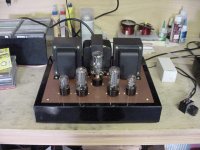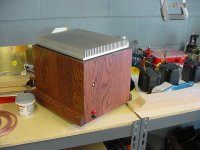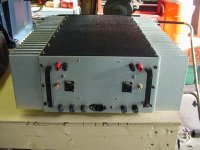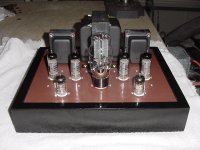Hi everyone; something odd happened here this morning that has me wondering - maybe you've ideas?
I was doing the first "with valves" test run of my DIY 6DJ8/6922 headphone amp (modded Morgan Jones circuit) and at first I thought something dreadful had happened with my workmanship. There was a bang and a brilliant violet flash inside one of the 6DJ8's (it was one of the White Cathode Followers) after which the amp produced music as though nothing amiss had happened.
Hmmmm! Okay, power down, test the valves again. All test fine - no shorts. Look over my workmanship and compare to schematic and valve socket diagrammes - no problems... Once more into the breach - and it's definitely the valve rather than the amp, since the fireworks followed the valve after I swapped the valves 'round....
Anyway, I replaced all the valves with some NOS JAN Philips 6922's I had lying about and all is well - I've been running it through the day and have gone through the powerup sequence (after discharging the PS caps) several times as tests.
Maybe this is a dumb question, but what the heck is the problem with that valve?? There was no extra 'hum' or 'hiss' from that valve - just a godawful 'crack' and an honest to god flash of violet lightning in there!
All the best,
Morse
I was doing the first "with valves" test run of my DIY 6DJ8/6922 headphone amp (modded Morgan Jones circuit) and at first I thought something dreadful had happened with my workmanship. There was a bang and a brilliant violet flash inside one of the 6DJ8's (it was one of the White Cathode Followers) after which the amp produced music as though nothing amiss had happened.
Hmmmm! Okay, power down, test the valves again. All test fine - no shorts. Look over my workmanship and compare to schematic and valve socket diagrammes - no problems... Once more into the breach - and it's definitely the valve rather than the amp, since the fireworks followed the valve after I swapped the valves 'round....
Anyway, I replaced all the valves with some NOS JAN Philips 6922's I had lying about and all is well - I've been running it through the day and have gone through the powerup sequence (after discharging the PS caps) several times as tests.
Maybe this is a dumb question, but what the heck is the problem with that valve?? There was no extra 'hum' or 'hiss' from that valve - just a godawful 'crack' and an honest to god flash of violet lightning in there!
All the best,
Morse
You know I had a Sovtek 6L6G that would not work until after the initial few seconds of warmup and then all was fine. I replaced it anyway but I found out that some of them come from the manufacturer not working right. It sounds like you got one, and it's not very funny at first but later when you stop to think about it... how high did you jump?
>>how high did you jump?<<
Oh, at least half a metre - I was wearing headphones at the time, carefully listening for the least signs of hum or hiss during the initial powerup!
- I was wearing headphones at the time, carefully listening for the least signs of hum or hiss during the initial powerup!  Come to think of it, the look on my face was probably pretty funny!
Come to think of it, the look on my face was probably pretty funny! 
Hmmm, interesting about your 6L6G; the only other valve I ever had play that game was a well worn Chinese made EL34 - however it was never the same after it's first 'flash and bang' (wouldn't hold bias and was noisy to boot).
All the best,
Morse
Oh, at least half a metre
Hmmm, interesting about your 6L6G; the only other valve I ever had play that game was a well worn Chinese made EL34 - however it was never the same after it's first 'flash and bang' (wouldn't hold bias and was noisy to boot).
All the best,
Morse
I have come to hate the smoke test portion of the program myself. I always get that turning your head, squinty eyed look about me as I insert the plug in the wall. You must be pretty brave to have on headphones the first time out
You must be pretty brave to have on headphones the first time out Next time have someone with a camera ready so you can share it with us. Hey, that would be a great idea for a funny thread wouldn't it?Enjoy your new toy.
Next time have someone with a camera ready so you can share it with us. Hey, that would be a great idea for a funny thread wouldn't it?Enjoy your new toy.
PassFan said:I have come to hate the smoke test portion of the program myself. I always get that turning your head, squinty eyed look about me as I insert the plug in the wall.You must be pretty brave to have on headphones the first time out

Guys, do yourselves a big favour and buy a variac. They're not expensive, especially to what an even minor ride in an ambulance must cost in the US. No more scary startups. Mine cost $A106 ($US60), surplus, nearly new for a 240V 16A version. I added a box around it for safety, and some terminals for meters for $A5.
Brett said:
Guys, do yourselves a big favour and buy a variac. They're not expensive, especially to what an even minor ride in an ambulance must cost in the US. No more scary startups. Mine cost $A106 ($US60), surplus, nearly new for a 240V 16A version. I added a box around it for safety, and some terminals for meters for $A5.
I have a variac that I use on SS. I didn't think they could be used on tube gear. Is this incorrect? I read "Valve Amplifiers" by Morgan Jones and he starts up his tube gear from a switch at full voltage from across the room. Will the heaters get hot enough at lower line voltages to safely find any faults?
Hi PassFan;
My understanding is that the idea of using a variac when testing out new valve kit is to take it easy on the PS caps by ramping up the voltage rather than just "letting 'er rip".
FWIW, over here I usually just make sure that the PS caps are pointed at something I wouldn't mind cleaning goo off of, put on my lab goggles, quietly mutter "contact" and let 'er rip.
>>Next time have someone with a camera ready so you can share it with us<<
I'll see about that ....it's going to be a little while though, due to budget cuts over here.
....it's going to be a little while though, due to budget cuts over here. 
All the best,
Morse
My understanding is that the idea of using a variac when testing out new valve kit is to take it easy on the PS caps by ramping up the voltage rather than just "letting 'er rip".
FWIW, over here I usually just make sure that the PS caps are pointed at something I wouldn't mind cleaning goo off of, put on my lab goggles, quietly mutter "contact" and let 'er rip.
>>Next time have someone with a camera ready so you can share it with us<<
I'll see about that
All the best,
Morse
PassFan said:
I have a variac that I use on SS. I didn't think they could be used on tube gear. Is this incorrect? I read "Valve Amplifiers" by Morgan Jones and he starts up his tube gear from a switch at full voltage from across the room. Will the heaters get hot enough at lower line voltages to safely find any faults?
You are correct that some filaments won't come up to fill emission at lower voltages, but often are enough to test with as you wind up the voltage for the first time (depends on circuit of course) at least enough to let you know if there is a short in the HV somewhere. Depending on what I'm firing up for the first time, I use a couple of different techniques.
A simple all in one test, is to make a special test lead that has a 150W or so globe wired <i>in series</i> with the active lead. For small draw preamps I'd use a 40W. Plugging it in and standing well away from the unit, if all is well, the light will glow brightly breifly, then fade to a dim glow as the PSU caps come up to full charge. If all looks OK, check the voltages in circuit, unplug and connect the correct lead. It should be safe now.
Over the years I've aquired some old transformers that let me set the filaments straight away from the mains, not via the variac, and even the fils of some indirectly heated diodes (all I use now) so I can wind the HV up slowly. Alternatively, I have some SS diode arrays that I can sub for a DH rectifier, usually with a power resisitor after it to get about the same voltage at the circuit. This way I can test for faults in the HV safely, by winding up the variac slowly and watching the I and V meters. I'll normally leave it running for a while like this, check voltages etc, power down and bleed off the caps, then install a DH rectifier (if used) and connect the filaments to the transformer that will actually power them in circuit. Then I plug into the rig I described above, and power up again, and check for the last time.
If an amp uses regulared DC for the fils, it's easy to test this way with AC, to check the amp works, and test the DC circuit seperately for faults (on your bench supply) before plugging it all in together. The more complicated a circuit, the chances of a fault rise exponentially with the complexity. Testing in modules eliminates that, and once you have a rig set up on your workbench, it's very simple and fast even if it sounds like more hassle. It also means that it saves you cooking an expensive multi secondary powertrans if the DC reg is faulty.
Whilst the first one is the easier method, I've had several amps do strange things in the past when powering up this way, having me chase faults that weren't there. However, if you build an amp rarely, it's the cheapest and simplest and usually reliable. The transformers I use in my bench rig for filaments cost me a few dollars total from surplus gear I've found over the years. The man I originally apprenticed under used a similar method, but had built a huge bench supply (AC, or DC with current limiting) for the filaments, and just plugged in or clip leaded to test. Wiring errors or faulty components were found in moments with no damage to anything else.
I'm a bit cautious now after seeing how badly you can be hurt by a simple mistake, that the test rig will find safely. I'd also rather see DIYers live to see their amp work. And the next one.....
For the extra half hour it takes to do even the most complicated test in my rig, it's still less time than replacing lots of components. Especially as the one you blow will have to be ordered, and you won't have a sub in the parts box.
Morse said:
FWIW, over here I usually just make sure that the PS caps are pointed at something I wouldn't mind cleaning goo off of, put on my lab goggles, quietly mutter "contact" and let 'er rip.
I'll see about that....it's going to be a little while though, due to budget cuts over here.
All the best,
Morse
That's funny stuff. That's what it's all about.
I understand about the budget cuts, they got me too. I have enough laying around already to start on a pair of monoblocks.
Morse said:Hi Passfan;
>>>I understand about the budget cuts, they got me too. I have enough laying around already to start on a pair of monoblocks.<<<
Hmmm, what have you got brewing there?
Good luck on your monoblocks!
Morse
If you go to the Tubecad site and look under Classic magazine articles (I think) you will see an ultralinear push-pull design for a 6L6GC. I ordered the iron last summer and finally got them last month (custom). Now to start the chassis and pick up some odds and ends.
I have some pics floating around here and the pass site of stuff I've done. I've been around this board for a while but I duck in and out a lot. Sometimes I have too many irons in the fire and sometimes I'm on the road working. Every now and then I get tired of building and kick back for a while to listen and let my hair grow back.

Hi Passfan;
Sounds like a cool project that'll fire up most any speaker!
Silly question, but have you got any kind of inspiration on a chassis design for your monoblocks? I'm doing the 'all wood with metal fittings' thing these days, but would like to try my hand at an all wood cathedral chassis for my first successful radio....
Hope the 6L6's turn out great!
Morse
Sounds like a cool project that'll fire up most any speaker!
Silly question, but have you got any kind of inspiration on a chassis design for your monoblocks? I'm doing the 'all wood with metal fittings' thing these days, but would like to try my hand at an all wood cathedral chassis for my first successful radio....
Hope the 6L6's turn out great!
Morse
- Status
- This old topic is closed. If you want to reopen this topic, contact a moderator using the "Report Post" button.
- Home
- Amplifiers
- Tubes / Valves
- With a bang and a flash - it works.....ideas anyone?




